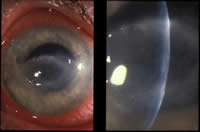DPD Home > A-Z Index > Acanthamoeba Infection Home > Diagnosis
Diagnosis
 |
|
| Eye of patient with Acanthamoeba kerititis. (Photo courtesy of Dan B. Jones, M.D.) | |
Early diagnosis is essential for effective treatment of Acanthamoeba keratitis. The infection is usually diagnosed by an eye specialist based on symptoms, growth of the ameba from a scraping of the eye, and/or seeing the ameba by a process called confocal microscopy.
Granulomatous Amebic Encephalitis (GAE) and disseminated infection are more difficult to diagnose and are often at advanced stages when they are diagnosed. Tests useful in the diagnosis of GAE include brain scans, biopsies, or spinal taps. In disseminated disease, biopsy of the involved sites (e.g., skin, sinuses) can be useful in diagnosis.
Related Diagnostic Links
For more information about laboratory diagnosis of Acanthamoeba infection, see the DPDx Web site: